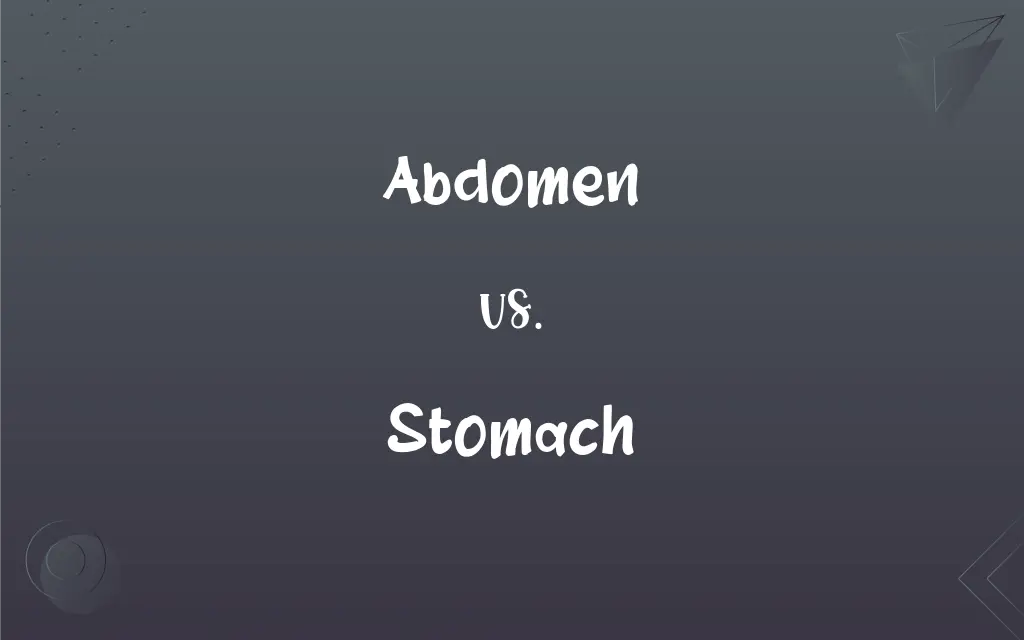Abdomen vs. Stomach: What's the Difference?
Edited by Aimie Carlson || By Harlon Moss || Updated on October 29, 2023
The abdomen is the part of the body between the chest and pelvis, while the stomach is an organ inside the abdomen that helps digest food.

Key Differences
The abdomen is a part of the body's anatomy, located between the chest and the pelvis. In contrast, the stomach is an internal organ that is a part of the digestive system. The abdomen houses the stomach along with other organs.
While the abdomen is made up of muscles and tissues that protect the internal organs, the stomach is made up of muscles and tissues that break down food. The abdomen is responsible for protecting and supporting the stomach and other organs.
The abdomen can be affected by various conditions such as abdominal pain or hernias. On the other hand, the stomach can be affected by conditions such as ulcers or acid reflux. Both the abdomen and the stomach play crucial roles in the functioning of the human body.
The term abdomen can refer to a similar area in other animals, while the stomach is specifically an organ in the digestive system. The abdomen can be further divided into regions to aid in the diagnosis of medical conditions, whereas the stomach has different regions that are related to its function in digestion.
Comparison Chart
Part of body's anatomy
Organ in the digestive system
Nature
ADVERTISEMENT
Houses stomach and other organs
Located in the abdomen
Location
Made up of muscles and tissues
Made up of muscles and tissues
Composition
Can be affected by various conditions
Can be affected by conditions
Health
Refers to similar area in other animals
Specifically an organ
Application in animals
Abdomen and Stomach Definitions
Abdomen
Abdomen is the part of the body between the chest and pelvis.
The doctor examined the patient's abdomen for any signs of swelling.
ADVERTISEMENT
Stomach
Stomach can be affected by conditions like ulcers.
The doctor prescribed medication to treat the patient's stomach ulcer.
Abdomen
Abdomen is made up of muscles and tissues.
Strong abdominal muscles can help support the back and improve posture.
Stomach
Stomach is made up of muscles and tissues.
The muscles of the stomach help to mix the food with digestive juices.
Abdomen
Abdomen can be divided into regions for diagnosis.
Pain in the upper right abdomen can indicate a problem with the liver.
Stomach
Stomach is specifically an organ in animals.
In some animals, the stomach has multiple compartments to aid in digestion.
Abdomen
Abdomen can refer to a similar area in other animals.
In insects, the abdomen contains the reproductive organs.
Stomach
Stomach is an organ in the digestive system that helps digest food.
The stomach produces acid to help break down food.
Abdomen
Abdomen houses the stomach and other organs.
The abdomen protects vital organs such as the stomach and intestines.
Stomach
Stomach is located in the abdomen.
The doctor palpated the patient's stomach to check for any abnormalities.
FAQs
What conditions can affect the stomach?
The stomach can be affected by conditions such as ulcers or acid reflux.
How does the abdomen affect posture?
Strong abdominal muscles can help improve posture.
What is the function of the stomach?
The stomach helps break down food.
What is the abdomen?
The abdomen is the part of the body between the chest and pelvis.
Can the abdomen refer to animals?
Yes, the term abdomen can refer to a similar area in other animals.
What is made up of the abdomen?
The abdomen is made up of muscles and tissues.
What is the stomach?
The stomach is an organ in the digestive system that helps digest food.
What is made up of the stomach?
The stomach is made up of muscles and tissues.
How does the stomach affect digestion?
The stomach produces acid to help break down food.
Can the abdomen be divided into regions?
Yes, the abdomen can be divided into regions for diagnosis.
What is located in the abdomen?
The abdomen houses the stomach and other organs.
What are some other conditions that can affect the stomach?
Other conditions that can affect the stomach include acid reflux and gastroparesis.
What conditions can affect the abdomen?
The abdomen can be affected by conditions such as abdominal pain or hernias.
How does the abdomen support the stomach?
The abdomen protects and supports the stomach and other organs.
Can the stomach refer to animals?
Yes, the stomach is specifically an organ in animals.
What is the function of the abdomen?
The abdomen helps protect and support the internal organs.
Can the stomach be divided into regions?
Yes, the stomach has different regions related to its function in digestion.
What can strong abdominal muscles help with?
Strong abdominal muscles can help support the back.
What other organs are located in the abdomen?
Other organs located in the abdomen include the intestines and liver.
How does the stomach mix food?
The muscles of the stomach help to mix the food with digestive juices.
About Author
Written by
Harlon MossHarlon is a seasoned quality moderator and accomplished content writer for Difference Wiki. An alumnus of the prestigious University of California, he earned his degree in Computer Science. Leveraging his academic background, Harlon brings a meticulous and informed perspective to his work, ensuring content accuracy and excellence.
Edited by
Aimie CarlsonAimie Carlson, holding a master's degree in English literature, is a fervent English language enthusiast. She lends her writing talents to Difference Wiki, a prominent website that specializes in comparisons, offering readers insightful analyses that both captivate and inform.































































